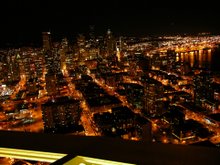Cliffhanger
Earlier this week, The Week published a short editorial with a simple question as its subtitle. What if, the magazine asks, images of mass shooting victims were published? It returns to the idea, asking some variation of the question, or about specific incidents, six times in the two paragraph body of the piece.
No effort, however, is made to answer it. One can imagine a simple experiment to test a hypothesis: publish some of the many photos that are taken of these scenes and see if that sparks any changes. The Week itself is unlikely to attempt such an approach due to, among other rationales, the "the sensibilities of readers." But another reason the magazine gives is: "preserving the dignity of the dead." But if, as the editorial hints, more members of the public seeing the images of the untimely dead might make it less likely that the victims of shootings would "be written off as the regrettable but necessary price of 'freedom'," that seems to indicate that "the dignity of the dead" is more valuable than the lives of the living.
But I'm not sure that either is particularly treasured by American society at large. While the readership of The Week may be disinclined to see bloody pictures of shooting victims, the response to photographs of the shootings in Allen, Texas being posted online shows that plenty of other people are interested in them. And in a nation where violence is often viewed as simply another tool for solving problems, including some that come across as trivial in the grand scheme of things, lives tend to be considered cheap. Especially those with the misfortune to be shot by someone who is disinterested in a body count.
Because why only worry about the images of those killed in mass shootings, with military-appearing weapons? A lone person murdered with a revolver or a double-barreled shotgun is just as dead, and just as much of a tragedy, as someone who is one of many. Why not ask why more images of those who die alone from gunshots are not published?
I don't know if I would look at such photographs myself. I'm squeamish when it comes to the sight of blood. (I don't do horror movies, either, for that same reason.) But, as someone, who is already past the point of seeing American gun culture as worth expending any effort to defend, I'm not sure that I'm one of the people that The Week's William Falk thinks needs to see such photos. Although I suspect there are activists out there who would advocate that I should be shown a steady stream of such photographs until I agreed to joint the cause.
I am, I think, getting ahead of myself, however. Because since the editorial declines to answer the questions it raises, there are nothing more than hints of what might happen. As much as I'm not a fan of journalism as advocacy, if one is going to advocate, advocate. Rather than simply suggest that afflicting the comfortable with gruesome images of gunshot victims would change the public calculus, state it, then stand by whatever decision one makes after that. It's not a tactic that I would engage in myself; as I noted, I'm squeamish, and am not the sort of inflict on others that which I shy away from. A New York Times article from a year ago "Should We Be Forced to See Exactly What an AR-15 Does to a 10-Year-Old?" (which Mr. Falk may have cribbed from) does a much better job of actually addressing the question, giving arguments pro and con, and then coming to a conclusion. Personally, I feel that the idea that politicians should see the photos lets the general public off the hook, but I understand the rationale.
At the Times article points out, in the end, it's more about people than photographs. And for all that mass shootings (however one defines them) tend to make breathless headlines, they're rare enough that most people are quite distant from the dead and injured. And they're farther still from most of the everyday survivors (or not) of gunshots. And not even the most graphic photographs can always bridge that gap.


No comments:
Post a Comment